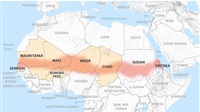American Museum of Natural History to remove Teddy Roosevelt statue

The American Museum of Natural History in New York
City will remove a statue of former president Theodore Roosevelt from outside
its main entrance.
The move, announced on Sunday, follows incidents
across the US in which statues of Confederate generals and leaders and other
historical figures linked to slavery and the dispossession of indigenous
Americans have been forcibly removed or destroyed.
In San Francisco on Friday a statue of another
president, Ulysses S Grant, was among monuments pulled down in Golden Gate
Park. Grant led Union armies to victory in the civil war and as president
fought the Ku Klux Klan. But before defeating the slave-owning Confederacy he
married into a slave-owning family and briefly owned a slave himself.
Roosevelt occupied the White House from 1901 to
1909. A keen outdoorsman and hunter, he helped form the museum’s collection.
Floyd, an African American man, was killed in May
when a Minneapolis police officer knelt on his neck for nearly nine minutes.
Protests over his death have expanded nationwide, to encompass other such
killings and all police brutality and systemic racism.
The statue at the museum on Central Park West in New
York shows Roosevelt, the 26th president, on horseback and flanked by an
African American and a Native American. It has been the target of protests and
calls for it to be taken down for some time. The museum has engaged with the
issue before.
A historic “Old New York” diorama inside the
building which shows Dutch settlers and Native Americans has been given labels
explaining its historical context.
“We have watched as the attention of the world and
the country has increasingly turned to statues as powerful and hurtful symbols
of systemic racism,” Futter said. “Simply put, the time has come to move it.”
The museum is part of New York state’s official
memorial to Roosevelt, who was born in New York City in 1858 and died on Long
Island in 1919.
In a statement, New York mayor Bill de Blasio, a
Democrat, said the museum had asked to remove the statue “because it explicitly
depicts black and indigenous people as subjugated and racially inferior. The
city supports the museum’s request. It is the right decision and the right time
to remove this problematic statue.”
What happens to the statue remains to be determined.
Theodore Roosevelt IV, a great-grandson of the
former president and museum trustee, told the Times he supported the decision.
“The world does not need statues, relics of another
age, that reflect neither the values of the person they intend to honor nor the
values of equality and justice,” he said. “The composition of the Equestrian
Statue does not reflect Theodore Roosevelt’s legacy. It is time to move the
statue and move forward.”
In recent years, Roosevelt’s views on race and his
role in the Spanish-American war have attracted criticism. At one protest in
2016, activists called the statue “a stark embodiment of the white supremacy
that Roosevelt himself espoused and promoted”.
The Times said Futter “made a point of saying that
the museum was only taking issue with the statue itself, not with Roosevelt
overall”.
“It’s very important to note that our request is
based on the statue, that is the hierarchical composition that’s depicted in
it,” she said. “It is not about Theodore Roosevelt who served as governor of
New York before becoming the 26th president of the United States and was a
pioneering conservationist.”







